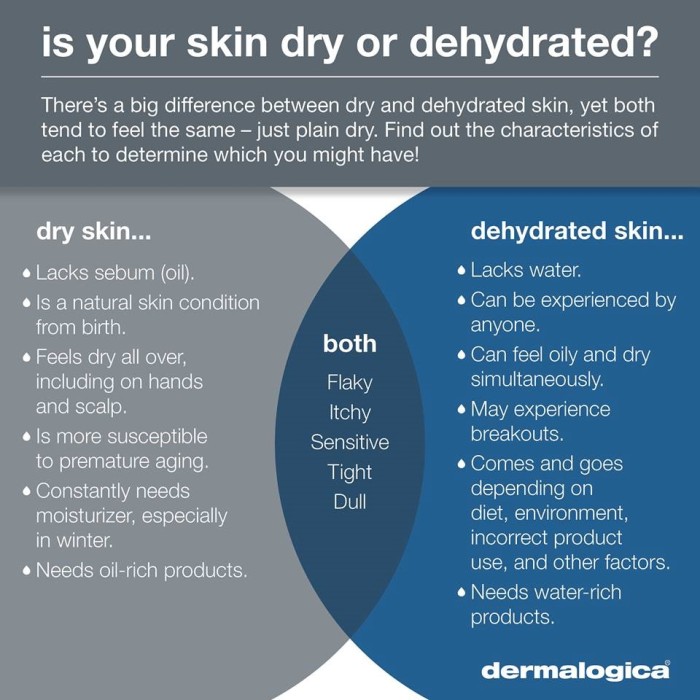Hello & welcome!This is the last post on Skin types, in the HEALTHY SKIN SERIES, we will be going into skin conditions next. But firstly, where is the Dry skin post. Hope you learn a thing a two.Dry skin develops as a result of under-active sebaceous glands. Dry skin, while hereditary like oily skin, is also a result of aging, as all body activities slow down with, oil gland activity slows as well. The lack of oil in dry skin reduces its ability to retain moisture since oil in the skin acts as a natural barrier against moisture.Symptoms for dry skin:
- Dry skin tend to be dehydrated, it can feel scaly, rough and itchy. It rarely has comedones, and when it does, they tend to be on the nose area.
- The lack of oil in dry skin reduces its ability to retain moisture since oil in the skin acts as a natural barrier against moisture.
- Dry skin is characterized as very fine, overly delicate, and thin. Insufficient oil secretion deprives the skin of enough glue to retain cells in the corneum layer. This leads to dry skin having fewer cells in the corneum layer than does oily skin.
- In dry skin, pores are almost invisible.
- The skin also tends to wrinkle easily and is often filled with tiny superficial lines, exhibits clearly visible white flakes and cracks. Its texture is rough and surface uneven.
 PIC CREDIT @ DERMALOGICALDry skin problems are aggravated by exposure to the sun, wind, and heat. Improper skin care, especially the lack of protection against moisture loss, further exacerbates this problem.Insufficient water intake and unfavorable environmental conditions, like low relative humidity, low temperatures, pollution, and air conditioning, contribute significantly to the incidence of dry skin. Such condition deteriorates in autumn, and winter due to rough clothes, particularly on skin areas with a low number of sebaceous glands, the arms, legs, and trunk.
PIC CREDIT @ DERMALOGICALDry skin problems are aggravated by exposure to the sun, wind, and heat. Improper skin care, especially the lack of protection against moisture loss, further exacerbates this problem.Insufficient water intake and unfavorable environmental conditions, like low relative humidity, low temperatures, pollution, and air conditioning, contribute significantly to the incidence of dry skin. Such condition deteriorates in autumn, and winter due to rough clothes, particularly on skin areas with a low number of sebaceous glands, the arms, legs, and trunk. How to Care for dry skin:
How to Care for dry skin:
- Skin care should include the use of products that will stimulate skin functions, activate oil gland secretion, and provide deep hydration. Moisturizers that can form a sealing film on the skin surface will prevent or reduce moisture loss. These should include high molecular weight ingredients, such as collagen, hyaluronic.
- Ingredients include but not limited to: glycolic, glycerin & urea- are commonly used moisturizer in natural cosmetic, ceramides and cholesterol are essential to activate the skin’s natural water retention ability and to place additional moisture into the skin.
- Nourishing creams that can stimulate oil gland secretion and skin functions are highly recommended, the use of products with antioxidant ingredients is essential to delay cellular damage, nourishing, hydrating masks is also advisable for dry skin.
Products for dry skin should contain:Moisturizer & humectants- ensure the skin’s adequate hydration by binding water emollients and occlusive.Appropriate ingredients for dry skin can include, but not are limited to, Vitamin E ( tocopherol, PCA, ginseng, dandelion extract, avocado oil, macadamia nut oil. Specifically beneficial botanical can include:St. John’s Wort: effective for improving circulationAloe Vera: for its deeply hydrating capacitiesSage: which is stimulating and invigoratingOrange flower extract: which is calming and soothing effects. Until the next remain blessedLove & LightNafsibotanical
[…] Dehydration skin is one of the most difficult skin conditions to recognize, due to the fact that usually confused with dryness, but the difference between is, while dehydration is caused by lack of water, dry skin technically lacks oil; both dehydration and dryness have many similarities; like both dry and oily skin type may be dehydrated. For more detail on OILY SKIN TYPE DRY SKIN TYPE […]
LikeLike
[…] DRY SKIN TYPE OILY SKIN TYPE NORMAL SKIN TYPE SKIN TYPES & SKIN CONDITIONS DEHYDRATION SKIN CONDITION! […]
LikeLike
[…] can affect dry skin DRY SKIN TYPE , flaky skin as well as normal skin NORMAL SKIN TYPE or oily skin OILY SKIN […]
LikeLike